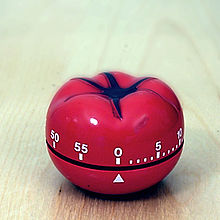Pomodoro Technique
The Pomodoro Technique is a time management method developed by Francesco Cirillo in the late 1980s.[1] The technique uses a timer to break down periods of work into 25-minute intervals called 'pomodori' (from the Italian word for 'tomato') separated by breaks. Closely related to concepts such as timeboxing and iterative and incremental development used in software design, the method has been adopted in pair programming contexts.[2] The method is based on the idea that frequent breaks can improve mental agility.[3][4]
There are five basic steps to implementing the technique:
- decide on the task to be done
- set the pomodoro (timer) to 25 minutes
- work on the task until the timer rings; record with an x
- take a short break (5 minutes)
- every four "pomodori" take a longer break (15–20 minutes)
Underlying principles
The stages of planning, tracking, recording, processing and visualizing are fundamental to the technique. In the planning phase tasks are prioritized by recording them in a "To Do Today" list. This enables users to estimate the effort tasks require. As "pomodori" are completed, they are recorded, adding to a sense of accomplishment and providing raw data for subsequent self-observation and improvement. For the purposes of the technique 'pomodoro' refers to an indivisible 25-minute period of time. An essential aim of the technique is to cut down on interruptions, both internal and external. This is done by recording and postponing other activities that interrupt the "pomodoro".[1]
Tools

The technique's author encourages a low-tech approach using a mechanical timer, paper and pencil. In his view the physical act of winding up the timer confirms the user's determination to start the task, and the ticking and ringing sounds are related to how the relationship to time will be conditioned by the technique.[1] Nonetheless, the technique has inspired a large number of software applications and timers for a variety of platforms,[5] perhaps because of the technique's following amongst software developers[citation needed].
Name
The Pomodoro Technique is named after the tomato-shaped kitchen timer that was first used by technique creator Francesco Cirillo when he was a university student (Pomodoro is Italian for tomato).[6]
See also
References
- ^ a b c Cirillo, Francesco. The Pomodoro Technique (PDF). ISBN 1445219948. Retrieved 2011-05-08.
- ^ Olsen, Patricia R. (September 2009)The New York Times- "For Writing Software, a Buddy System"
- ^ Shellenbarger, Sue (2009-11-18). "''Shellenbarger, Sue'' (November 2009) The Wall Street Journal - "Testing Time Management Strategies"". Online.wsj.com. Retrieved 2010-10-27.
- ^ "''Tambini, Arielle; Ketz, Nicholas; Davachi, Lila'' "Enhanced Brain Correlations during Rest Are Related to Memory for Recent Experiences" Neuron (January 2010)". Cell.com. Retrieved 2010-10-27.
- ^ Sande, Steven (2009-11-28). "The Pomodoro Technique, or how a tomato made me more productive". Tuaw.com. Retrieved 2010-10-27.
- ^ "FAQ - The Pomodoro Technique™". Pomodorotechnique.com. 2010-06-28. Retrieved 2010-10-27.
Further reading
- Free PDF of Francesco Cirillo's book
- Template:It icon Free PDF of Francesco Cirillo's book
- Template:Cn icon Free PDF of Francesco Cirillo's book
- Staffan Nöteberg: Pomodoro Technique Illustrated: The Easy Way to Do More in Less Time. Pragmatic Programmers, Raleigh, N.C., 2009, ISBN 978-1934356500
